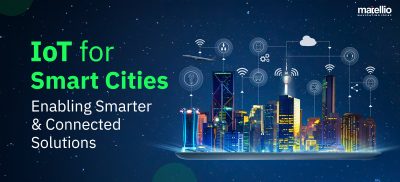
In this era of digital transformation services, the Internet of Things (IoT) is revolutionizing how we interact with the world around us, and cellular connectivity is playing a pivotal role in this transformation.
Through this blog, we delve deep into the realm of Cellular IoT platforms, exploring how they connect devices and empower industries, enhance everyday experiences, and drive innovation at an unprecedented scale. Whether through the widespread reach of 4G and 5G networks, the power-efficient nature of NB-IoT, or the enhanced connectivity of LTE-M, cellular IoT platform development bridges gaps between the digital and physical worlds in ways we could have only imagined a few years ago.
Let’s unlock the potential of Cellular IoT!
Definition and Overview of Cellular IoT Platform
Cellular IoT uses cellular networks to connect Internet of Things (IoT) devices. Unlike traditional mobile connectivity, which focuses on high data rate digital transformation services like streaming and browsing, cellular IoT is designed to transmit small amounts of data over vast areas, focusing on reliability, power efficiency, and deep penetration. This makes it suitable for various IoT app developments that require remote and long-term connectivity. Here are some of core technologies that Cellular IoT uses:
NB-IoT (Narrowband IoT)
NB-IoT is designed for devices that require low power consumption, making it ideal for applications where devices need to operate for years. It offers low power consumption and comprehensive coverage but with low data rates. Suitable for static, low-bandwidth applications.
LTE-M (LTE Cat-M1)
LTE-M, short for Long-Term Evolution for Machines, or LTE Cat-M1, is a low-power wide-area network (LPWAN) technology standard explicitly developed for machine-to-machine (M2M) and IoT consulting services. It’s part of the cellular LTE technology family and is designed to meet the requirements of IoT devices, including low power consumption, extended coverage, and lower complexity.
5G IoT
5G technology significantly enhances IoT capabilities by supporting many connected devices simultaneously, essential for large-scale IoT app development like smart cities or industrial automation. Its low latency ensures real-time data processing, crucial for applications requiring immediate response, such as autonomous vehicles and remote medical procedures.
Importance and Benefits of Cellular IoT Connectivity Platform Development!
Cellular connectivity plays a crucial role in the Internet of Things (IoT), offering significant benefits that make it a preferred choice for many custom enterprise software development. Here’s a breakdown of the importance and benefits of cellular IoT connectivity platform development:
Wide Coverage
Cellular networks, such as 4G/LTE and the emerging 5G, offer extensive coverage. This is crucial for IoT devices operating in remote or widespread areas, such as transportation and logistics applications.
Reliability
Cellular connections are typically more reliable than other wireless options. They offer stable and consistent connectivity, essential for critical IoT applications in healthcare or industrial automation sectors.
High Speed and Capacity
With the advent of 5G, cellular networks provide high data speeds and greater capacity. This benefits IoT services that require real-time data processing and analytics, such as video surveillance and autonomous vehicles.
Low Power Options
Digital transformation services like LTE-M and NB-IoT are designed for IoT applications. They consume less power, which is vital for devices that need battery power for extended periods, such as agricultural sensors or wearable health monitors.
Enhanced Security
Cellular networks offer robust security features, including encryption, authentication, and secure SIM-based connections. This is important for protecting sensitive data transmitted by IoT devices.
Scalability
Cellular IoT platforms can quickly scale from a few devices to millions, allowing businesses to expand their IoT solutions as needed without significant changes to the infrastructure.
Global Standardization
Cellular technologies are globally standardized, simplifying the development and deployment of IoT solutions across different regions without worrying about compatibility.
Simplicity and Integration
Cellular IoT connectivity platform development can be easily deployed and connected to existing cellular networks, reducing the complexity of setting up and managing separate connectivity infrastructure.
Mobility
Cellular connectivity is ideal for mobile IoT applications, such as fleet tracking and management, where devices constantly move.
Quality of Service (QoS) Management
Cellular networks can prioritize traffic, which is crucial for mission-critical IoT applications where data transmission needs to be ensured under all circumstances.
What is a Cellular IoT Platform?
Cellular IoT platform development is a comprehensive framework that enables developing, deploying, and managing Internet of Things (IoT) applications and devices using cellular network technology. This platform supports IoT devices connected to the internet through cellular networks like 2G, 3 G, 4G/LTE, and the latest 5G networks.
Key Features of a Cellular IoT Platform
Cellular IoT platforms, designed to connect various devices over cellular networks, encompass several key features that enable efficient, reliable, and scalable IoT solutions. Here are some of the primary features:
Wide Area Connectivity
Leveraging existing cellular networks (like LTE, 5G, NB-IoT, LTE-M) for wide-area coverage, ensuring connectivity even in remote areas.
Low Power Operation
Support for low-power protocols like NB-IoT and LTE-M is crucial for devices that need long battery life, such as sensors in remote locations.
Scalability
The ability to support many devices simultaneously is crucial for large-scale IoT-based custom enterprise software development.
Security
Robust security features include data encryption, secure authentication, and SIM-based security to protect against unauthorized access and data breaches.
Real-Time Data Processing
Capability to process and analyze data in real-time, enabling immediate responses and decision-making.
Cloud Integration
Seamless integration with cloud platforms for data storage, analytics, and additional computing resources, facilitating advanced IoT applications.
Device Management
Tools for remote device provisioning, monitoring, and management are essential for indeed maintaining the health and performance of IoT devices.
Quality of Service (QoS) Management
Ensuring reliable and consistent connectivity and data transmission is critical for applications requiring high reliability, like health monitors or industrial automation.
Multi-Band Support
Compatibility with multiple cellular bands, allowing for global deployment and roaming capabilities.
Edge Computing Capabilities
Support for processing data locally on devices (edge computing) to reduce latency and bandwidth usage.
Interoperability
Ability to work with various devices and protocols, ensuring compatibility across manufacturers and ecosystems.
Customizable Data Plans
Flexible data plans cater to varying needs of different IoT applications, from low-data requirement devices like sensors to high-data needs like video surveillance.
OTA Updates
Over-the-air (OTA) firmware and software updates to ensure devices are always running on the best software versions.
APIs for Integration and Telecom Software Development
Providing developers with APIs to integrate cellular IoT functionalities into existing systems or to develop new applications.
Data Analytics and Reporting Tools
Advanced tools for analyzing collected data to gain insights and generate reports, aiding decision-making processes.
These features collectively make cellular IoT platforms powerful tools for businesses and IoT solutions that are secure, scalable, and capable of handling the complex needs of modern IoT ecosystems.
Core Technologies Behind Cellular IoT Platform Development
Cellular IoT uses cellular networks to connect Internet of Things (IoT) devices. The core technologies behind the Cellular IoT platform are a blend of communication standards, protocols, cloud and edge computing technologies, security measures, power management techniques, and device management strategies. This mix is crucial in addressing the diverse requirements and challenges of IoT applications, from simple sensor networks to complex industrial IoT systems. Let’s delve into these core technologies:
Cellular Communication Standards
- 2G/GPRS/EDGE: Early standards are now mostly phased out due to limited data rates and efficiency.
- 3G/UMTS: Improved data rates and coverage but still limited for modern IoT needs.
- 4G/LTE: Offers higher data rates and more efficient spectrum use. LTE categories like Cat-1 and Cat-4 are used in IoT consulting services but are more suited for applications requiring higher data throughput.
- NB-IoT (Narrowband IoT): Designed specifically for IoT, offering low power consumption and the ability to connect many low-throughput devices over a wide area. Ideal for static or low-mobility devices.
- LTE-M (LTE Cat-M1): A low-power wide-area network (LPWAN) technology that provides good coverage, higher data rates than NB-IoT, and support for voice and mobile applications.
- 5G: The latest standard with promising higher data rates and lower latency. 5G ability to connect massively scaled IoT networks.
It enable for new IoT-based custom enterprise software development, particularly those requiring real-time data processing and high-speed connectivity.
IoT Protocols and Communication Standards
- MQTT (Message Queuing Telemetry Transport): A messaging protocol, ideal for many IoT apps due to its low bandwidth requirement and effective data transmission.
- CoAP (Constrained Application Protocol): A web transfer protocol designed for constrained devices and networks.
- HTTP/HTTPS: Commonly used for IoT applications but can be heavier on bandwidth and power.
Cloud Integration and Edge Computing
- Cloud Platforms: The cloud serves as a central repository for data collected from IoT devices, offering scalable storage solutions. It provides powerful computing resources for complex data processing, analysis, and machine learning tasks. IoT app development and services are often hosted in the cloud, enabling users to access and manage functions remotely. IoT devices often connect to cloud platforms (like AWS IoT, Azure IoT Hub, and Google Cloud IoT) for data storage, processing, and analytics.
- Edge Computing: Edge computing involves processing data locally at the network’s edge, near or on the IoT devices. It enables immediate data analysis and decision-making at the device level, which is crucial for time-sensitive applications. Reduces the amount of data that needs to be sent to the cloud, thereby saving bandwidth and reducing latency.
Security Technologies
- SIM-based Security: Uses SIM cards for authentication on cellular networks, ensuring secure communication.
- End-to-end Encryption: Essential for securing data in transit from IoT devices to the cloud or data centers.
- Secure Boot and Trusted Execution Environment (TEE): Ensures IoT devices boot with trusted software and provides a secure environment for sensitive operations.
Power Management
- Power-saving Modes: PSM (Power Saving Mode) and eDRX (extended Discontinuous Reception) are crucial for extending the battery life of IoT devices.
Data Management and Analytics
- Big Data Analytics: For analyzing large volumes of data generated by IoT devices.
- AI and Machine Learning: IoT consulting services enables intelligent data processing and decision-making, often essential in predictive maintenance, anomaly detection, and optimizing operations.
Device Management and OTA Updates
- OTA (Over-the-Air) Updates: For remotely updating the firmware and software of IoT devices to ensure security and functionality.
Developing Cellular IoT Platform
Developing a Cellular IoT platform involves a series of steps, each critical to ensuring the platform’s functionality, scalability, and reliability. Here’s an overview of the critical telecom software development steps:
Requirements Analysis
Understand the specific goals and applications of the IoT platform (e.g., asset tracking, smart city applications). Determine technical and business requirements, including coverage, scalability, data rate, latency, and power consumption needs. Engage with all relevant stakeholders, including end-users, to gather comprehensive requirements.
| IoT Devices/Sensors | Devices equipped with cellular modules (e.g., NB-IoT, LTE-M) for connectivity. |
| Microcontrollers & Processors | ARM Cortex, ESP32, or similar, depending on the computational needs. |
| Cellular Modules | Such as SIMCOM, Quectel, or u-blox, for connecting to cellular networks. |
| Peripheral Interfaces | For connecting sensors and actuators. |
| Cellular Networks | Utilizing 4G/LTE, 5G, NB-IoT, or LTE-M for comprehensive area connectivity. |
| SIM Management | eSIM or traditional SIM card management solutions. |
| Communication Protocols | MQTT, CoAP, HTTP/S for device-to-server communication. |
| Cloud Service Providers | AWS IoT, Azure IoT, and Google Cloud IoT for scalable cloud infrastructure. |
| IoT Platform Services | Services like AWS IoT Core and Azure IoT Hub for device management and data ingestion. |
| Identity and Access Management (IAM) | To indeed secure and manage resource access. |
| Databases | Time-series databases like InfluxDB or general-purpose databases like PostgreSQL or MongoDB. |
| Data Processing | Apache Kafka and RabbitMQ for message queuing and streaming. |
| Big Data Analytics | Apache Spark and Hadoop for processing large datasets. |
| Backend Development | Node.js, Python, and Java for writing server-side logic. |
| Frontend Development | React and Angular are used for user interface development. |
| APIs | RESTful APIs for integration with other systems and services. |
| Web Server | Nginx, Apache for hosting web applications. |
| Encryption | TLS/SSL for secure data transmission. |
| Authentication | OAuth2.0, JWT for secure access. |
| Data Security | Encryption at the rest and in transit, secure coding practices. |
| Containerization | Docker and Kubernetes for container management and orchestration. |
| CI/CD | Jenkins, GitLab CI for automation. |
| Monitoring and Logging | Prometheus, Grafana, and ELK Stack for system monitoring and log management. |
| Machine Learning & AI | TensorFlow, PyTorch for advanced data analytics and predictive maintenance. |
| Edge Computing | Technologies like AWS Greengrass or Azure IoT Edge for local data processing and reduced latency. |
Design and Architecture
Design the system architecture, including device, network, and application layers. Incorporate security measures, including encryption, authentication, and secure boot. Plan for data collection, processing, storage, and analytics.
Prototyping
Build initial prototypes to test the concept and basic functionality. Conduct small-scale pilot tests to evaluate performance and gather initial feedback.
Platform Development
Develop and optimize firmware for IoT devices. Ensure seamless integration with cellular networks and manage network connectivity. Develop the application layer, including user interfaces and application logic.
Security Implementation
Implement security measures across the entire platform. Conduct security audits to indeed identify and mitigate vulnerabilities.
Testing and Validation
Test for all functional requirements of the platform. Evaluate the performance, including network latency and throughput. Test the platform’s scalability to handle an increasing number of devices. Ensure compatibility with different devices and network standards.
Deployment
Develop a phased rollout strategy for deployment. Set up the necessary infrastructure, including servers and network connections. Deploy IoT devices and ensure they are correctly connected and configured.
Monitoring and Maintenance
Monitor the platform for performance, security, and functionality. Regularly update firmware and software for enhancements and security. Provide ongoing support and maintenance services.
Feedback and Iteration
Collect feedback from users and stakeholders. Continuously improve the platform based on user feedback and evolving requirements.
Also Read- IoT Product Development: Use Cases and Development Process
Conclusion
The success of a cellular IoT platform hinges on a meticulously chosen technology stack that ensures robust performance, security, and ease of integration. Each component plays indeed an important role in the platform’s overall functionality, from hardware selection to cloud infrastructure. The future of IoT is undeniably intertwined with the advancements in cellular technology, particularly with the widespread adoption of 5G, which promises to enhance IoT connectivity exponentially in terms of speed, number of devices, and reduced latency.
As we look ahead, it’s clear that cellular IoT will not just be a component of the future – it will be a driving force shaping it.
FAQs
How is data analytics integrated into cellular IoT platforms?
Custom Cellular IoT platforms provide analytics tools to process and analyze data generated by IoT devices, enabling businesses to derive meaningful insights for decision-making.
What role does edge computing play in cellular IoT platforms?
Edge computing in cellular IoT platforms allows for processing data closer to the source, reducing latency and enhancing real-time decision-making capabilities.
Can a cellular IoT platform handle different types of devices and sensors?
Yes, cellular IoT platforms are designed to support a variety of devices and sensors, enabling the development of diverse IoT applications.
Which cellular technologies are commonly used in IoT platforms?
Common cellular technologies include NB-IoT (Narrowband IoT), LTE-M (LTE for Machines), and 5G, each with its own advantages and use cases.
How does cellular IoT differ from other IoT connectivity options?
Cellular IoT uses existing cellular networks (e.g., 4G, 5G, NB-IoT) for connectivity, providing wider coverage and more reliable connections compared to some other IoT connectivity options like Wi-Fi or Bluetooth.





